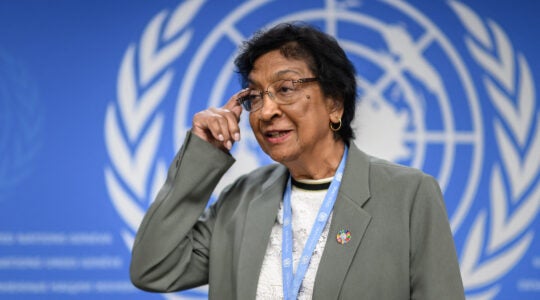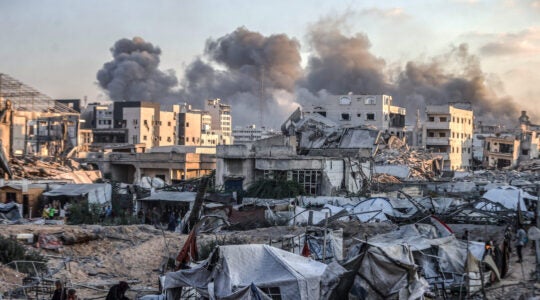
Fishing the modern way at Kibbutz Ma’agan Michael. (Hagai Nativ)
FIRST PERSON
LOS ANGELES (JTA) — When I left South Africa to volunteer to be a soldier in the Israel Defense Forces in 1971, Kibbutz Ma’agan Michael agreed to host me for the duration of my military service.
My assigned residence at the kibbutz — located about 20 miles south of Haifa, on the Mediterranean coast — was a single room in a wooden shack without running water, air conditioning or other modern conveniences. The nearest showers and toilets were public and situated at least 100 yards from my spartan abode.
It was a far cry from the way I live today at the kibbutz — in a roomy three-bedroom apartment equipped with all the latest electronics and a spacious porch that opens onto a stretch of manicured lawn surrounded by variegated bougainvilleas.
In many ways this dichotomy encapsulates much of the change that has taken place over the past few decades in the kibbutz movement in Israel, and at Ma’agan Michael in particular. There has been a dramatic metamorphosis affecting not only the outward appearance of the kibbutz and sources of its livelihood, but also the manner in which it perceives itself and is perceived by others.
In the past few decades, Ma’agan Michael has changed from a tiny, impoverished fishing village into a sprawling, affluent community with a variety of industrial, commercial and agricultural activities. Today the major source of income is Plasson, a multimillion dollar global plastics manufacturing corporation whose shares are traded on the Tel Aviv Stock Exchange.
The shift reflects how kibbutzim have deviated sharply from their socialist roots into full-fledged participants in the capitalist system.
As Israel’s most successful kibbutz, Ma’agan Michael has preserved a high degree of cooperative life. At less prosperous kibbutzim, economic hardship has forced privatization of elements that once were collective.
In stark contrast to its former ideology of asceticism, today’s kibbutz is replete with once-scorned human comforts and privately owned gadgetry. In fact, much of Ma’agan Michael’s communal activity is conducted online from members’ private homes, where they can reserve a car from the kibbutz’s ample fleet, submit work schedules or receive medical test results conducted at the inhouse clinic.
The dominant ethos that characterized the kibbutz well into the 1970s was that of members who were rugged warrior-farmers strongly rooted to the land, willing to sacrifice life and limb to defend Israel. For a young man eligible for military service, it was taboo not to serve in a combat unit. Societal emphasis and social stature was focused more on the physical than the cerebral. While academic study was not overtly shunned, any pursuit not deemed absolutely necessary for the acquisition of skills to enhance the kibbutz’s productive operations often elicited expressions of suspicion and derision.
Today, however, every child of Ma’agan Michael members is guaranteed the opportunity to attain an academic degree or some chosen equivalent without any connection to future earning potential. Similar developments have taken place in virtually all of Israel’s kibbutzim.
A watershed moment for the kibbutz movement came in 1977, when a Likud government was sworn into power for the first time and kibbutz members feared that their long-maligned political opponents, whom they had labeled as fascists, would seize kibbutz assets. Hasty economic decisions were made that began the chain of events that brought many kibbutzim to the brink of economic collapse. Interestingly, religious kibbutzim, which viewed Likud’s ascent with far more equanimity than their secular counterparts and reacted with less alarm, fared far better economically.
The importance of military service as a social imperative declined. Service in non-combat capacities in the IDF — even draft evasion — were treated with increasing tolerance.
As the kibbutz began casting off the mantle of national leadership, the social rewards of membership diminished commensurately. As the sense of belonging to society’s elite waned, many members — particularly the more talented and younger ones — began leaving the kibbutz for the lure of the city. This move, once considered the ultimate act of betrayal, became acceptable and commonplace.
Although Ma’agan Michael largely has been spared the detrimental impact of this phenomenon, it devastated the kibbutz work force and jeopardized the future of many other kibbutzim.
If current trends continue, kibbutzim likely will be overtaken sooner or later by the very bourgeois materialism they once held in such contempt.
However, this is far from inevitable. There is sincere soul-searching going on in Ma’agan Michael about the community’s future: how to maintain social solidarity in an age of individualism and how to fashion the kibbutz’s role in society at large.
It is premature to write the epitaph of the kibbutz movement. Even without individual financial rewards, Ma’agan Michael’s members have brought the kibbutz to the forefront of global achievement in agriculture — particularly animal husbandry, aquiculture and orchard cultivation.
Furthermore, the continued contribution of the kibbutz movement to the Israeli military should not be underestimated. In my family, virtually all the men served as officers in elite combat units – Air Force, Navy and special forces. This is not unusual. In recent military operations, kibbutz combatants were among those with the highest casualty rates — a sign that kibbutzim still contribute in high proportions to Israel’s combat forces.
It is not at all clear where the kibbutz will be in 2020 or what form it will take. But those who predict its inevitable demise may be surprised.
(Martin Sherman is a professor in security studies at Tel Aviv University and this year is the American-Israeli Cooperative Enterprise/Schusterman Visiting Professor at the University of Southern California and Hebrew Union College-Jewish Institute of Religion in Los Angeles.)
JTA has documented Jewish history in real-time for over a century. Keep our journalism strong by joining us in supporting independent, award-winning reporting.





